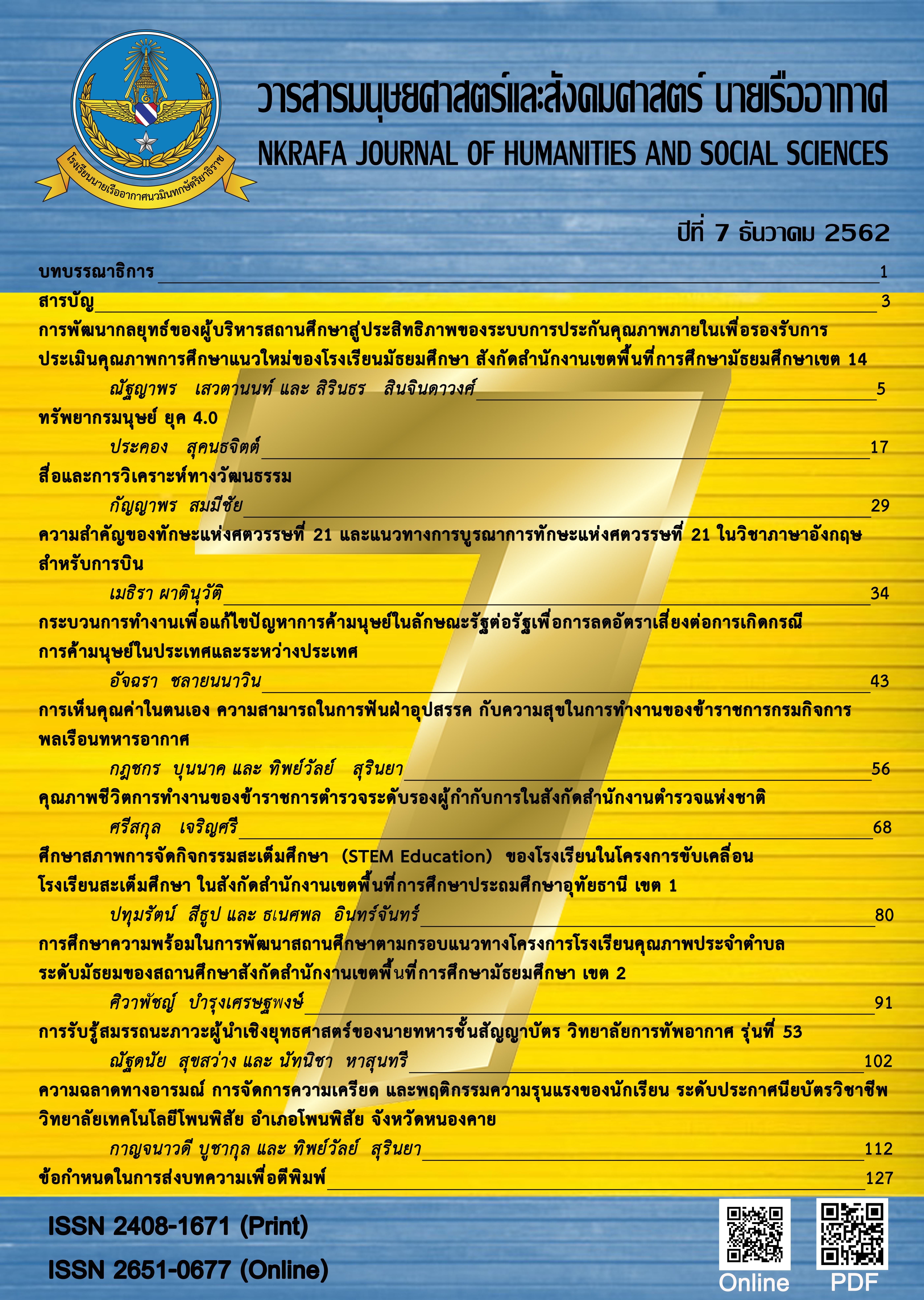The Working Process for Human Trafficking Resolution in order to Reduce the Risk of Human Trafficking Incidents over the Cross Border Region
Main Article Content
Abstract
The study on “The working process for human trafficking resolution in order to reduce the risk of human trafficking incidents over the cross border region” has an objective to address the issue of trafficking over the cross border region. The study aims to help people who are victims of trafficking using state to state policy. The data was collecting from relevant authorities with the organization who help assisting the human trafficking victim. Using focus groups and in-depth interviews analysis from 25 samples, the results showed that the victims often were affected by severe economic conditions, including lack of income and debt as the intention driving them to abroad. Thus, this could be substantially increasing risk for victim to re-trafficked again. All States should cooperate in order to provide a budget to treat the victim appropriately. The government should provide relief centers. A free medical examination, welfare, and medical care should provide the victim for free. When the victim stopped to care for and rehabilitate themselves The housing, translation services and consultation at the same time should provide training and workforce skills so that the victims can return into normal life again.
Article Details
บทความที่ได้รับการตีพิมพ์เป็นลิขสิทธิ์ของวารสารมนุษยศาสตร์และสังคมศาสตร์ นายเรืออากาศ
ข้อความที่ปรากฎในบทความแต่ละเรื่องในวารสารวิชาการเล่มนี้ เป็นความคิดเห็นส่วนตัวของผู้เขียนแต่ละท่าน ไม่เกี่ยวข้องกับโรงเรียนนายเรืออากาศฯ และคณาจารย์ท่านอื่น ๆในโรงเรียนนายเรืออากาศฯ แต่อย่างใด ความรับผิดชอบขององค์ประกอบทั้งหมดของบทความแต่ละเรื่องเป็นของผู้เขียนแต่ละท่าน หากมีความผิดพลาดใด ๆ ผู้เขียนแต่ละท่านจะรับผิดชอบบทความของตนเองแต่เพียงผู้เดียว
References
Nataliya Opanovych, “Human Trafficking for Sex Explotation in Thailand2016,” Collegium Civitas, Poland, 2016.
Nataliya Opnovych, “Human Trafficking for sex exploitation in Thailand,” [Online]. Available: https://www.civitas.edu.pl/wp-content/uploads/2015/03/Securitologia-1_23_2016_103-110.pdf, Poland, 2012. [Accessed: 20 June 2019].
United States Agency for International Development, “Trafficking in Person,” USAID, USA, 2002.
GAATW, “Human Rights in Practice: Aguide to Assist Trafficked Women and Children,” GAATW, Bangkok, 1999.
L. Dorman, “Trafficking women and girls in Asia,” Together, UK, 2000.
ILO, “Getting at the Roots Stopping Exploitation of Mogrant Workers by Organized Crime,” ILOItaly, 2002.
UNICEF, “Every Last Child Fullfill the Right of Women and Children in East Asia and the Pacific,” UNICEF, USA, 2000.
Phongpaichit Piriyarangsan, “Gun Girls Bambling Ganja Thailand Illegal Economy and Public Policy,” [Online]. Available: http://hrw.org/press/1994/01/thaiburma.htm, BKK, 1998. [Accessed: 20 June 2019].
L. Dorman, “Trafficking wimen and girls in Asia,” Together, UK, 2000.
Human Right Watch, “Owed Justice Thai Women Trafficked into Debt Bondage in Japan,” Human Right Watch, USA, 2000.
Human Right Watch, “Thai Women Trafficked intoDebt Bondae in Japan,” [Online]. Available: https://www.hrw.org/reports/2000/japan/6-sec-6-7-8.htm, USA, 2000. [Accessed: 20 June 2019].
EU, “EU support to fight human trafflicking in South/South East Asia,” [Online]. Available: https://www.eca.europa.eu/Lists/ECADocuments/SR17_9/SR_HUMAN_TRAFFICKING_EN.pdf, EU, 2017. [Accessed: 20 June 2019].
Z. Dumienski, “Citical Reflections on Anti-human trafficking,” NTS, Singapore, 2011.
Save the Children Nepal, “Definition of Trafficking,” [Online]. Available: https://web.archive.org/web/20071120150137/http://www.savethechildren.net/nepal/key_issues/traffdefinition.html, Nepal, 2007. [Accessed: 20 June 2019].
C. Aradau, “The perverse politics of four-letter words: risk and pity in the securitisation of human trafficking", Journal of International Studies, Chicago, March 1, 2004 pagee 251-277.
Amnesty International, “"Anti-trafficking measures 'not fit for purpose' and breach international law – new report".,[Online]. Available: https://www.amnesty.org.uk/press-releases?NewsID=18820, UK, 2018. [Accessed: 20 June 2019].
P. Project, “"Combating Human Trafficking and Modern-day Slavery".,[Online]. Available: https://polarisproject.org/index.php, USA, 2017. [Accessed: 25 June 2019].
EU, “ Council of Europe Convention on Action against Trafficking in Human Beings,” [Online]. Available: http://www.coe.int/en/web/conventions/full-list/-/conventions/treaty/197/signatures?p_auth=Gn9RcCwG, EU, 2010. [Accessed: 25 June 2019].
EU, “Council of Europe Convention on the Protection of Children against Sexual Exploitation and Sexual Abuse,” [Online]. Available: http://conventions.coe.int/Treaty/Commun/ChercheSig.asp?NT=201&CM=&DF=&CL=ENG, EU, 2007. [Accessed: 20 June 2019].
Government of India, “Press Information Bureau,” [Online]. Available: http://pib.nic.in/newsite/PrintRelease.aspx?relid=104002, India, 2014. [Accessed: 20 June 2019].
U. c. s. a. h. trafficking, “Poverty and Human Trafficking,” [Online]. Available: http://www.stopenslavement.org/assets/uscsaht-02.pdf, US, 2016. [Accessed: 20 June 2019].


